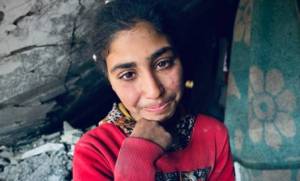(UNRWA)* — Alaa is a young teenager from the Zaytoun neighborhood in the Gaza Strip. She and her family, along with most of the population in Gaza, have been displaced to Rafah, all searching for safety from Israeli bombardments.
Living in the Rubble: Alaa’s Harrowing Story of Displacement
Rafah is now overrun with internally displaced people (IDPs) seeking shelter. Home to only 300,000 people before the start of the war, it now hosts some 1.5 million Palestinians.
Alaa’s story of displacement, fear, and sadness is shared by hundreds of thousands of other children.

In search of privacy from the masses, Alaa and her family have taken shelter in the ruins of a heavily damaged building. “The place is very dark, and light only enters through narrow openings in the debris. What’s even more difficult is the smell the missile left behind,” Alaa said.

As her family struggles with their current circumstances, Alaa helps in any way she can. From starting a fire on their makeshift stove, to watching over the food cooking on it or fetching water, Alaa and her siblings have taken on responsibilities far beyond their years.
As the war enters its sixth month, hunger and desperation have set in. February saw a sharp decrease in the number of aid trucks granted access to the besieged Gaza Strip compared to rates during January.
However, even January rates fell far below the average of 500 trucks which entered daily before the start of hostilities. The slight increases in the flow of aid so far in March have still fallen far short of what is needed.
In January the World Health Organization conducted nutrition screenings in shelters and health centres in northern Gaza. They found that 1 in 6 children under the age of two were acutely malnourished.
Almost 3 per cent of these already suffered from severe wasting, the most life-threatening form of malnutrition, which puts young children at high risk of medical complications and death in the absence of immediate medical treatment.
Even in light of this grave situation, a 14-truck World Food Programme convoy was turned away on 5 March after a three-hour wait at a checkpoint in Wadi Gaza.
Like so many thousands of other children in Gaza, the pain and anxiety experienced over the past few months are etched into Alaa’s face. The trauma of what she has managed to survive will follow her for years to come.
The ongoing war has shattered Gaza’s social structure, with nearly 32,000 Palestinians killed, and another 74,000 reportedly injured to date. About 70 per cent of those killed are reported to be women and children.
Over 70 per cent of the homes in Gaza have been either destroyed or damaged. And more than 75 per cent of the population has been displaced, most of them multiple times.
All 625,000 children in Gaza are now deprived of education; of these, nearly 300,000 are enrolled in UNRWA schools, the same schools that are now being used as shelters by more than 1 million internally displaced people.
Gaza today is facing a severe mental health crisis affecting everyone, but especially vulnerable groups like families, people with disabilities, the elderly and the infirm, women, and children like Alaa.
UNRWA continues to provide psychosocial support services, including psychosocial first aid, psychosocial support consultations and intervention sessions, sessions on handling psychological fatigue, as well as group and recreational activities.
UNRWA has delivered a range of such services more than one million times to individuals and groups.
Alaa expressed her hopes for displacement to end and a safe return home, saying, “We continue to hope for a ceasefire, even if it means living under a tent in the rubble.”
*SOURCE: UNRWA. Go to ORIGINAL: https://www.unrwa.org/newsroom/features/living-rubble-alaa’s-harrowing-story-displacement

Leave a comment